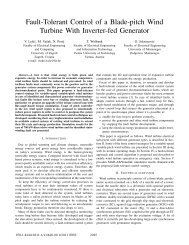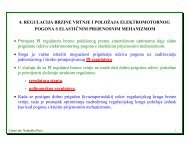Damping of Wind Turbine Tower Oscillations through Rotor Speed ...
Damping of Wind Turbine Tower Oscillations through Rotor Speed ...
Damping of Wind Turbine Tower Oscillations through Rotor Speed ...
You also want an ePaper? Increase the reach of your titles
YUMPU automatically turns print PDFs into web optimized ePapers that Google loves.
model with concentrated parameters. This can<br />
be done using modal analysis that is very<br />
common tool in wind turbine analysis [1], [3].<br />
It describes a complex oscillatory structure as<br />
a composition <strong>of</strong> several simple oscillatory<br />
systems each <strong>of</strong> them being described by<br />
means <strong>of</strong> mass, stiffness and damping. By this<br />
representation complex tower oscillations are<br />
seen as a sum <strong>of</strong> many simple oscillations<br />
characterized by their modal frequencies<br />
which are one <strong>of</strong> the most important structural<br />
properties <strong>of</strong> wind turbine. It has been shown<br />
in practice [5] that fairly good modeling <strong>of</strong><br />
wind turbine tower nodding can be achieved<br />
using two modal frequencies (two modes).<br />
Since we are here primarily interested in<br />
building model suitable for controller design<br />
we use only the first modal frequency. The<br />
justification for this lies in the fact that for the<br />
turbine in scope second modal frequency is<br />
more than 6 times greater than the first modal<br />
frequency and therefore falls out <strong>of</strong> the<br />
controller frequency bandwidth.<br />
By using only one modal frequency tower<br />
dynamics can be described as:<br />
Mx �� + Dx� + Cx = F , (9)<br />
t t t<br />
where M, D, and C are modal mass damping<br />
and stiffness respectively and F is the<br />
generalized force that is originated by wind<br />
and that causes wind turbine tower<br />
oscillations. <strong>Tower</strong> modal properties in<br />
expression (9) are related to first tower modal<br />
frequency ω0t as follows [4]:<br />
D= 2 ζ ω ⋅M,<br />
t 0t<br />
2<br />
0t<br />
( ω )<br />
C = ⋅M,<br />
(10)<br />
where ζ t is structural damping. For steel<br />
structure structural damping is mostly set to<br />
0.005 [4]. Modal mass M can be calculated as<br />
[1]:<br />
ht<br />
0<br />
( ) ( ) 2<br />
φ<br />
M = ∫ m h h dh,<br />
(11)<br />
where ht is the height <strong>of</strong> the tower, m(h) is the<br />
mass distribution along the tower and φ ( h)<br />
is<br />
the tower's first mode shape. Note that actual<br />
distribution <strong>of</strong> mass along tower has to be<br />
modified in order to include mass <strong>of</strong> the rotor<br />
and the nacelle which is assumed to be<br />
concentrated at the tower top.<br />
Driving force F is mostly the rotor thrust force<br />
Ft caused by wind. It can be shown [4] that<br />
thrust force, similar to aerodynamic torque,<br />
depends upon wind speed, rotor speed and<br />
pitch angle. So similarly to (6) it can be<br />
expressed as [4]:<br />
1 2 2<br />
Ft = ρairR πvwCt( λ, β)<br />
, (12)<br />
2<br />
where Ct is so called thrust coefficient.<br />
Expressions (6), (8), (9) and (12) form the<br />
simplified nonlinear model <strong>of</strong> wind turbine<br />
that is used in the following sections for<br />
controller design. Model is summarized below<br />
taking into account the fact that wind speed<br />
seen by the rotor is a sum <strong>of</strong> wind speed and<br />
tower nodding speed:<br />
J � tω= Mr −Mg −Ml,<br />
1 3<br />
2<br />
Mr = ρairR πCQ( λ, β)<br />
⋅( vw −x�t)<br />
,<br />
2<br />
. (13)<br />
1 2<br />
2<br />
Ft = ρairR πCt( λ, β)<br />
⋅( vw −x�t)<br />
,<br />
2<br />
F = Mx �� + Dx�+ Cx.<br />
t t t t<br />
Torque and thrust coefficients Cq and Ct are<br />
usually provided by wind turbine blade<br />
manufacturers or can be calculated using<br />
pr<strong>of</strong>essional simulation tools.<br />
4. PID Controller<br />
The PID controllers are still by far the most<br />
used controllers for wind turbine speed and<br />
power control. This is due to their simplicity<br />
and rather high robustness. The small number <strong>of</strong><br />
parameters makes possible for designer to<br />
quickly arrive at satisfactory, although in many<br />
cases suboptimal, system behavior. As stated<br />
before wind turbine dynamics change in<br />
nonlinear fashion with change in wind speed.<br />
To control the wind turbine with linear<br />
controllers gain scheduling has to be used [3].<br />
Although it seems straightforward to use wind<br />
speed as scheduling criterion this is not an<br />
appropriate solution since the wind speed is not<br />
measured fast and accurately enough. Therefore<br />
measured pitch angle is usually used as<br />
scheduling variable.<br />
For the design <strong>of</strong> a PID controller using<br />
analytical methods process model (13) has to<br />
be linearised around chosen operating point.<br />
After linearization <strong>of</strong> expressions (13) and







